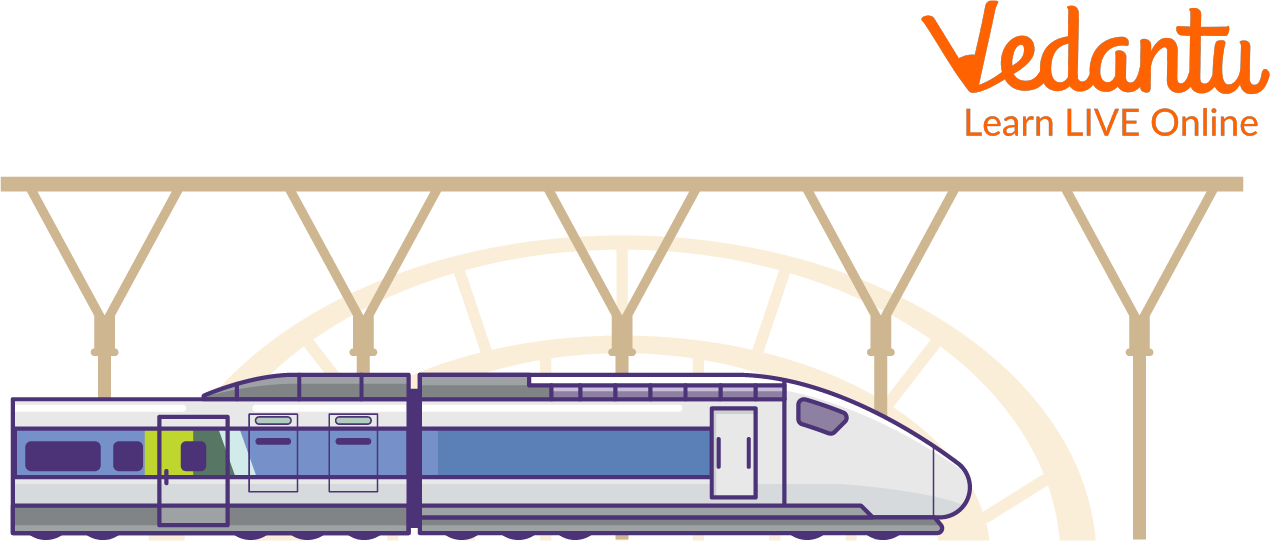




How to Calculate Speed of a Train: Methods and Sample Problems
Hey kids, have you ever wondered while riding a train what the speed of the train you are travelling might be? Or what might be the speed of the train running in the opposite direction of your train?
To measure the train's speed, we need to know the total distance the train covers on that journey and the time taken to cover that journey. Thus, an object's speed is determined by how much its position changes over time or how much it changes in a certain amount of time.

Train
Speed:
The most important scientific concept is measurement. Base or fundamental physical units measure a wide range of measurable quantities. Speed is a scalar quantity since it has one direction and no magnitude.
The formula to measure speed is given:
${\rm{Speed}}\left( S \right) = \frac{{{\rm{Distance}}\left( D \right)}}{{{\rm{Time Taken}}\left( t \right)}}$
When time is measured in hours and distance is measured in kilometres, the unit of measurement for speed is in kilometres per hour or km/hr. Speed is measured in "m" per "min," or m/min if the distance is measured in metres and the time is measured in minutes.
Average Speed:
Speed is how fast something is moving or the movement of something at a specific time. Average speed refers to the average speed during the period of a journey. To determine average speed, divide the total distance travelled by the time required to complete that distance.
The formula to measure the average speed is given:
${\rm{Average Speed}}\left( {\rm{S}} \right) = \frac{{{\rm{Total Distance}}}}{{{\rm{Total Time Taken}}}}$
Calculate Speed of Train:
The calculations on rail distance depend upon various things:
When a Train Moves by a Still Object:
The train's engine must move the same amount as the train when the train's terminus passes the object. The length of the train and its speed are then equal to the amount of time it takes to pass the stationary object.
When a Train Passes an Object with Some Length:
The train's engine must travel a distance equal to the sum of the lengths of the train and stationary object when the end of the train passes an object that is stationary and has some length. Therefore,
${\rm{Time taken by train}} = \frac{{\left( {{\rm{length of the train}} + {\rm{length of the still object}}} \right)}}{{{\rm{speed of the train}}}}$
Trains Running in the Same Direction:
The speed of two trains travelling in the same direction equals the difference in their speeds.
Trains Running in Different Directions:
The speed of two trains travelling in opposition to one another is equal to the product of their speeds.
Train Speed Formula:
The formulas used to measure train speed are given below:
$x{\rm{ km/hr}} = x \times \left( {\frac{5}{{18}}} \right){\rm{m/s}}$
$x{\rm{ m/s}} = x \times \left( {\frac{{18}}{5}} \right){\rm{km/hr}}$
Train Math Problem:
Let us look at some problems with trains worksheet answers:
Example 1:
Calculate how long a railway would take 250 m long and move at 50 km/hr to cross the pole.
Solution:
From the given question,
Length of the train = 250 m and speed of the train = 50 km/hr
The formula to find the speed of the train is ${\rm{Speed}}\left( S \right) = \frac{{{\rm{Distance}}\left( D \right)}}{{{\rm{Time Taken}}\left( t \right)}}$.
Substitute the values in the given formula,
$\begin{array}{l}50 = \frac{{250}}{t}\\t = \frac{{250}}{{50}}\\t = 5hr\end{array}$
Therefore, the time taken by the railway to cross the pole is 5hr.
Example 2:
A train that is 300 metres long is moving at a 5 m/sec speed. How long will it take to travel through a 200 m tunnel?
Solution:
From the given question,
Length of the train = 300 m, length of the tunnel = 200 m and speed of the train = 5 m/sec
$\begin{array}{c}{\rm{Total length}} = {\rm{Length of train}} + {\rm{Length of tunnel}}\\{\rm{ = }}\left( {{\rm{300 + 200}}} \right)m\\ = 500m\end{array}$
The formula to find the speed of the train is ${\rm{Speed}}\left( S \right) = \frac{{{\rm{Distance}}\left( D \right)}}{{{\rm{Time Taken}}\left( t \right)}}$.
Substitute the values in the given formula,
$\begin{array}{l}5 = \frac{{500}}{t}\\t = \frac{{500}}{5}\\t = 100s\end{array}$
Therefore, it will take the train 100 seconds to travel through a 200m tunnel.
Conclusion:
We need to take care of a few things, such as the direction the trains are travelling in, the motion of the object, or its length, to determine the distance the trains have travelled. We can also use tools like a rail distance calculator to measure the distance travelled by rail.
The distance covered by two trains, whether travelling in the same direction or in opposition, is therefore equal to the sum of their lengths.
FAQs on Speed of Train: Concepts, Formulas & Applications
1. What is the average speed of a train?
Express trains often travel between 36 kilometres per hour or 22 miles per hour and 113 kilometres per hour or 70 miles per hour.
2. Why are trains the most secure?
No unexpected cars are coming your way that could cause us to lose control of the wheel. There are no sudden changes in direction or other challenging circumstances that could be dangerous. This could be one factor that has kept trains among the safest modes of transportation so far.
3. Why can't the train stop quickly?
Even in emergencies, trains take a long time to stop because of their size, weight, and speed. When the brakes are applied, the train may travel more than a mile of the track before stopping.





















